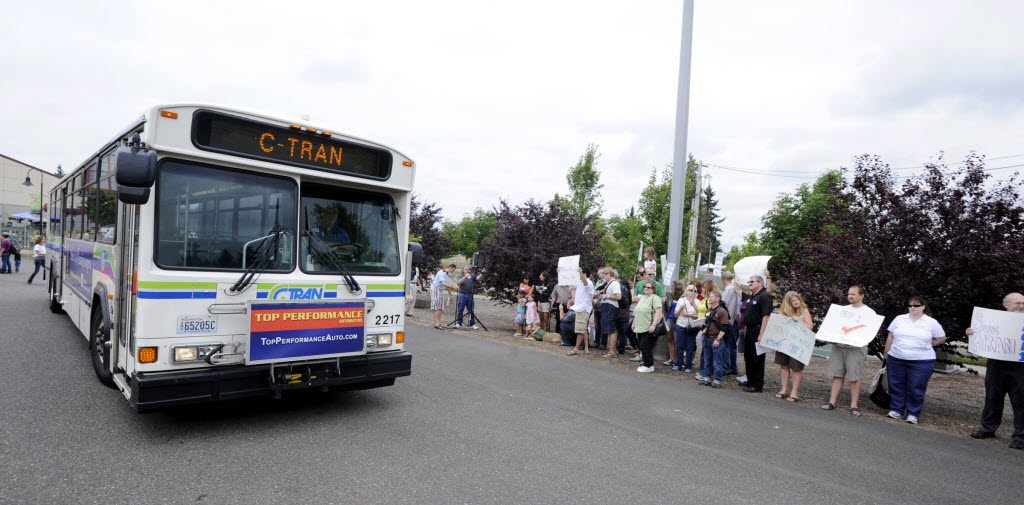In the still-evolving debate over how to pay for maintaining new high-capacity transit systems in Vancouver, C-Tran leaders are so far sticking with Plan A.
That’s sending a sales tax measure to voters in November, which the agency’s board committed to last year.
But with that vote still more than nine months away — it’s not even officially on the ballot yet — local leaders are already tossing around ideas for Plan B. At the same time, they’re treading carefully to deliver on past promises to voters in a politically charged environment.
“There’s a lot of dynamics, a lot of balls in the air, a lot of complexities to this that are being weighed,” said Vancouver Mayor Tim Leavitt, one of nine voting C-Tran board members.
High-capacity transit refers to two separate endeavors in Vancouver: a proposed bus rapid transit system on the city’s Fourth Plain corridor, and a downtown light rail line planned as part of the more than $3 billion Columbia River Crossing project. Both are banking on federal funding to get built. The question is how to cover their maintenance and operation costs once construction is complete.
Much of the conversation has centered around light rail. Besides another sales tax hike — just last year, voters approved a local increase of 0.2 percent to maintain bus service — other financing options run the gamut, Leavitt said. Money could come from a fare-based model leaning heavily on riders, for example, or a city motor vehicle license tax, he said. The city or C-Tran itself could decide to take on the burden from general funds, he added.
Leavitt stressed that any such option would need further vetting, and is far from a sure thing. But participants in his recently
formed advisory committee have indicated they’d like to at least explore other options besides a second sales tax increase in as many years, Leavitt said.
Each of those options would carry its own complexities and hurdles. The city taking on transportation funding would require the blessing of the C-Tran board, said agency public affairs director Scott Patterson. C-Tran dipping into its own funds to cover light rail operating costs might require a reversal of board policy — in the run-up to last year’s Proposition 1 election, board members specifically stated that they wouldn’t use sales tax revenue from that measure toward light rail or any aspect of the Columbia River Crossing.
Clark County’s share of light rail operation costs is expected to land just above $2.5 million per year, Patterson said. Regardless of where that money comes from, a plan must be in place before the Federal Transit Administration will write the check to build the line, he said.
“If there’s no commitment in place,” Patterson said, “then the FTA is not going to let the project receive that.”
Oregon’s Tri-Met already operates the existing portion of the MAX Yellow Line from the Rose Quarter to the Expo Center in Portland. The CRC project would extend the line across the Columbia River to Clark College.
Despite ongoing questions, C-Tran leaders are still moving forward with this November’s planned sales tax measure. Board members this month began the state-mandated expert review panel process to make that happen. But the decision came only after a lengthy discussion over whether that’s the best way forward. Some members raised the possibility of a nonbinding “advisory vote” that wouldn’t be tied to a tax, but would simply gauge public opinion on light rail and give voters a chance to weigh in — as promised.
This November’s vote ties light rail with Vancouver’s other high-capacity transit project, bus rapid transit. C-Tran is hoping to identify a preferred BRT plan this spring. And with CRC plans already thoroughly vetted, C-Tran officials have said the review panel would likely devote more of its attention to BRT.
Even if C-Tran stays the course on a second sales tax measure this year, other key questions remain unresolved. Board members have wrestled with the matter of who should vote — C-Tran’s entire taxing district, or a smaller subdistrict centered around Vancouver. The board may tackle that question as soon as March.
Whatever the outcome, the agency will have to act soon, said Vancouver City Councilor Larry Smith, C-Tran’s board chair. A ballot measure has to be finalized by this summer to make it onto the November ballot.




